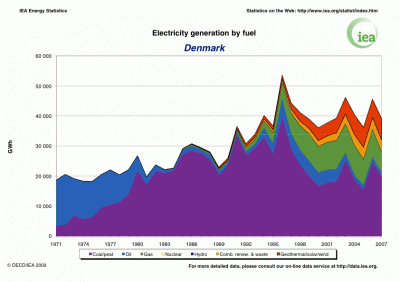| Wind Watch is a registered educational charity, founded in 2005. |
Danish Electricity Generation by Fuel, 1971-2007
Share:
Translate: FROM English | TO English
Translate: FROM English | TO English
Note that 1996 was a peak year for electricity generation and renewables were not largely used. Total electricity generation declined to a low in 2000 and has been rising again since,
Coal replaced oil from the 1970s through the 1980s, but the 1990s saw oil increasing again, along with natural gas. Since 2000, both have declined slightly, with coal making up more than the difference. Since 2000, the share of renewables in Denmark’s generation has actually declined. (Since 2004, no new wind capacity has been added.)
Denmark generates more electricity than it uses, but as noted in the analysis by Hugh Sharman, “Why wind power works for Denmark” (Civil Engineering, May 2005), almost all of the wind energy has to be exported “” from the west to Norway and Sweden, where hydro can readily balance it, and from the east to Germany, where the much larger grid can more easily handle it. It is sold at a loss.
And while they are an electricity exporter, they are even more an importer. According to the Danish Energy Authority’s 2003 Energy Flows chart, they imported 242 PJ of oil for electricity generation (producing about 82 PJ) and 25 PJ of electricity itself. They exported 56 PJ of electricity, a number suspiciously close to the 63 PJ of electricity production from renewables (mostly from wind, presumably).
(A petajoule [PJ] is equivalent to about 278,000 gigawatt-hours of electrical energy.)
Download original document: “Danish Electricity Generation by Fuel, 1971-2007”
This material is the work of the author(s) indicated. Any opinions expressed in it are not necessarily those of National Wind Watch.
The copyright of this material resides with the author(s). As part of its noncommercial educational effort to present the environmental, social, scientific, and economic issues of large-scale wind power development to a global audience seeking such information, National Wind Watch endeavors to observe “fair use” as provided for in section 107 of U.S. Copyright Law and similar “fair dealing” provisions of the copyright laws of other nations. Queries e-mail.
| Wind Watch relies entirely on User Funding |
 (via Stripe) |
 (via Paypal) |
Tags: Wind power, Wind energy
